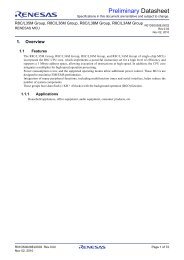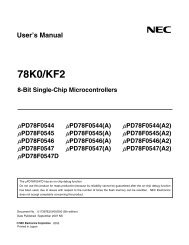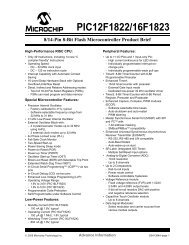xmega a3u - Elfa
xmega a3u - Elfa
xmega a3u - Elfa
Create successful ePaper yourself
Turn your PDF publications into a flip-book with our unique Google optimized e-Paper software.
XMEGA A3U<br />
8. DMAC – Direct Memory Access Controller<br />
8.1 Features<br />
8.2 Overview<br />
• Allows high speed data transfers with minimal CPU intervention<br />
– from data memory to data memory<br />
– from data memory to peripheral<br />
– from peripheral to data memory<br />
– from peripheral to peripheral<br />
• Four DMA channels with separate<br />
– transfer triggers<br />
– interrupt vectors<br />
– addressing modes<br />
• Programmable channel priority<br />
• From 1 byte to 16MB of data in a single transaction<br />
– Up to 64KB block transfers with repeat<br />
– 1, 2, 4, or 8 byte burst transfers<br />
• Multiple addressing modes<br />
– Static<br />
–Incremental<br />
– Decremental<br />
• Optional reload of source and destination addresses at the end of each<br />
–Burst<br />
–Block<br />
– Transaction<br />
• Optional interrupt on end of transaction<br />
• Optional connection to CRC generator for CRC on DMA data<br />
The four-channel direct memory access (DMA) controller can transfer data between memories<br />
and peripherals, and thus offload these tasks from the CPU. It enables high data transfer rates<br />
with minimum CPU intervention, and frees up CPU time. The four DMA channels enable up to<br />
four independent and parallel transfers.<br />
The DMA controller can move data between SRAM and peripherals, between SRAM locations<br />
and directly between peripheral registers. With access to all peripherals, the DMA controller can<br />
handle automatic transfer of data to/from communication modules. The DMA controller can also<br />
read from memory mapped EEPROM.<br />
Data transfers are done in continuous bursts of 1, 2, 4, or 8 bytes. They build block transfers of<br />
configurable size from 1 byte to 64KB. A repeat counter can be used to repeat each block transfer<br />
for single transactions up to 16MB. Source and destination addressing can be static,<br />
incremental or decremental. Automatic reload of source and/or destination addresses can be<br />
done after each burst or block transfer, or when a transaction is complete. Application software,<br />
peripherals, and events can trigger DMA transfers.<br />
The four DMA channels have individual configuration and control settings. This include source,<br />
destination, transfer triggers, and transaction sizes. They have individual interrupt settings. Interrupt<br />
requests can be generated when a transaction is complete or when the DMA controller<br />
detects an error on a DMA channel.<br />
To allow for continuous transfers, two channels can be interlinked so that the second takes over<br />
the transfer when the first is finished, and vice versa.<br />
8386B–AVR–12/11<br />
17

















